airbag off Hyundai Terracan 2003 Owner's Manual
[x] Cancel search | Manufacturer: HYUNDAI, Model Year: 2003, Model line: Terracan, Model: Hyundai Terracan 2003Pages: 349, PDF Size: 4.56 MB
Page 22 of 349
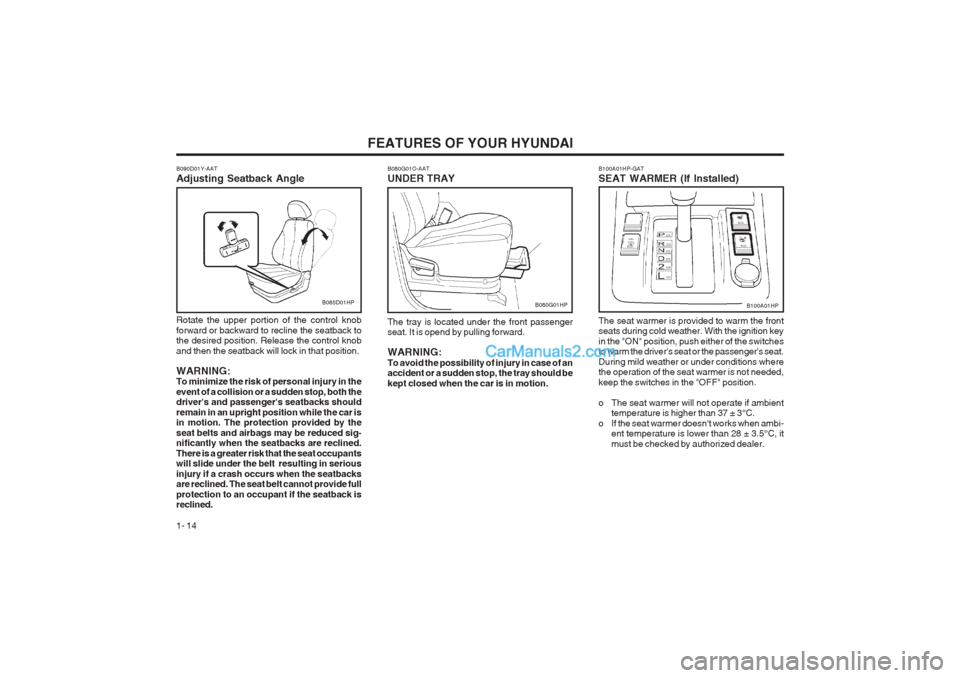
FEATURES OF YOUR HYUNDAI
1- 14
B100A01HP-GAT SEAT WARMER (If Installed) The seat warmer is provided to warm the front seats during cold weather. With the ignition key in the "ON" position, push either of the switches to warm the driver's seat or the passenger's seat. During mild weather or under conditions where the operation of the seat warmer is not needed, keep the switches in the "OFF" position.
o The seat warmer will not operate if ambient temperature is higher than 37 ± 3°C.
o If the seat warmer doesn't works when ambi- ent temperature is lower than 28 ± 3.5°C, it must be checked by authorized dealer.
B100A01HP
B080G01O-AAT UNDER TRAY
B080G01HP
The tray is located under the front passenger seat. It is opend by pulling forward. WARNING: To avoid the possibility of injury in case of an accident or a sudden stop, the tray should be kept closed when the car is in motion.B085D01HP
B090D01Y-AAT Adjusting Seatback Angle Rotate the upper portion of the control knob forward or backward to recline the seatback to the desired position. Release the control knob and then the seatback will lock in that position. WARNING: To minimize the risk of personal injury in the event of a collision or a sudden stop, both the driver's and passenger's seatbacks should remain in an upright position while the car is in motion. The protection provided by the seat belts and airbags may be reduced sig- nificantly when the seatbacks are reclined. There is a greater risk that the seat occupants will slide under the belt resulting in serious injury if a crash occurs when the seatbacks are reclined. The seat belt cannot provide full protection to an occupant if the seatback is reclined.
Page 35 of 349
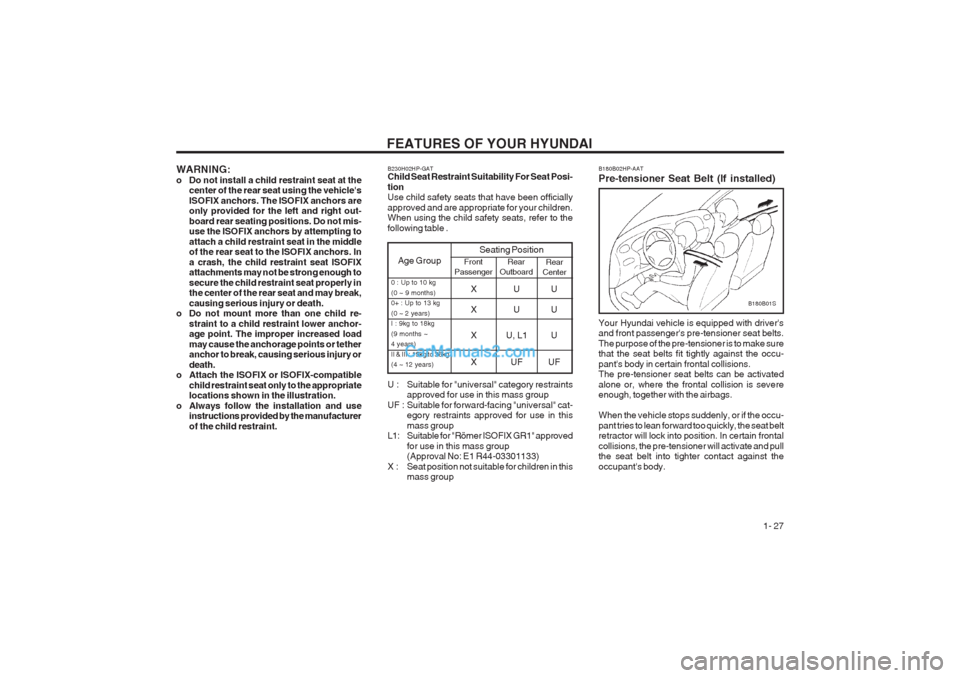
FEATURES OF YOUR HYUNDAI 1- 27
WARNING:
o Do not install a child restraint seat at the
center of the rear seat using the vehicle'sISOFIX anchors. The ISOFIX anchors are only provided for the left and right out- board rear seating positions. Do not mis- use the ISOFIX anchors by attempting to attach a child restraint seat in the middle of the rear seat to the ISOFIX anchors. In a crash, the child restraint seat ISOFIX attachments may not be strong enough to secure the child restraint seat properly in the center of the rear seat and may break, causing serious injury or death.
o Do not mount more than one child re-
straint to a child restraint lower anchor- age point. The improper increased load may cause the anchorage points or tether anchor to break, causing serious injury or death.
o Attach the ISOFIX or ISOFIX-compatible
child restraint seat only to the appropriate locations shown in the illustration.
o Always follow the installation and use instructions provided by the manufacturer of the child restraint.
Age Group Seating PositionFront
Passenger Rear
Outboard Rear
Center
0 : Up to 10 kg (0 ~ 9 months) 0+ : Up to 13 kg (0 ~ 2 years) I : 9kg to 18kg (9 months ~ 4 years) II & III : 15kg to 36kg (4 ~ 12 years)XUU
XUU
X U, L1 U XU FUF
B230H02HP-GAT Child Seat Restraint Suitability For Seat Posi- tion Use child safety seats that have been officially approved and are appropriate for your children. When using the child safety seats, refer to the following table .
U : Suitable for "universal" category restraints
approved for use in this mass group
UF : Suitable for forward-facing "universal" cat- egory restraints approved for use in this mass group
L1: Suitable for "Römer ISOFIX GR1" approved
for use in this mass group (Approval No: E1 R44-03301133)
X : Seat position not suitable for children in this mass group Your Hyundai vehicle is equipped with driver'sand front passenger's pre-tensioner seat belts. The purpose of the pre-tensioner is to make sure that the seat belts fit tightly against the occu- pant's body in certain frontal collisions. The pre-tensioner seat belts can be activated alone or, where the frontal collision is severe enough, together with the airbags. When the vehicle stops suddenly, or if the occu- pant tries to lean forward too quickly, the seat belt retractor will lock into position. In certain frontal collisions, the pre-tensioner will activate and pull the seat belt into tighter contact against the occupant's body.
B180B02HP-AAT Pre-tensioner Seat Belt (If installed)
B180B01S
Page 36 of 349
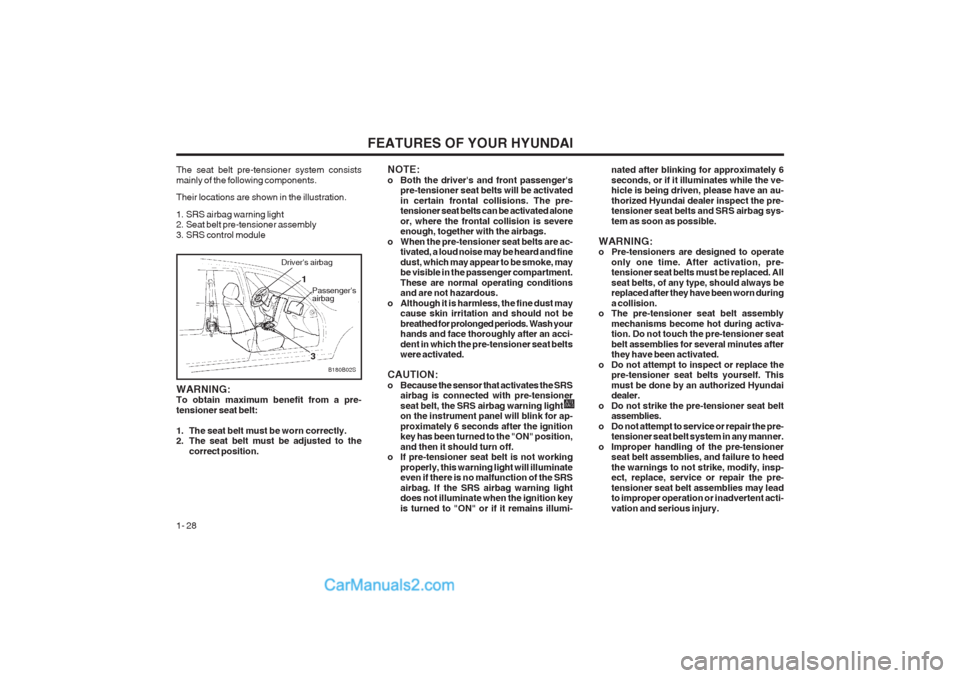
FEATURES OF YOUR HYUNDAI
1- 28 nated after blinking for approximately 6 seconds, or if it illuminates while the ve- hicle is being driven, please have an au- thorized Hyundai dealer inspect the pre- tensioner seat belts and SRS airbag sys- tem as soon as possible.
WARNING:
o Pre-tensioners are designed to operate only one time. After activation, pre-tensioner seat belts must be replaced. All seat belts, of any type, should always be replaced after they have been worn during a collision.
o The pre-tensioner seat belt assembly
mechanisms become hot during activa- tion. Do not touch the pre-tensioner seat belt assemblies for several minutes after they have been activated.
o Do not attempt to inspect or replace the pre-tensioner seat belts yourself. This must be done by an authorized Hyundai dealer.
o Do not strike the pre-tensioner seat belt assemblies.
o Do not attempt to service or repair the pre- tensioner seat belt system in any manner.
o Improper handling of the pre-tensioner seat belt assemblies, and failure to heed the warnings to not strike, modify, insp- ect, replace, service or repair the pre- tensioner seat belt assemblies may lead to improper operation or inadvertent acti- vation and serious injury.
The seat belt pre-tensioner system consistsmainly of the following components. Their locations are shown in the illustration.
1. SRS airbag warning light
2. Seat belt pre-tensioner assembly
3. SRS control module
B180B02S
Driver's airbag
1
3
Passenger's airbag
WARNING: To obtain maximum benefit from a pre- tensioner seat belt:
1. The seat belt must be worn correctly.
2. The seat belt must be adjusted to the correct position. NOTE:
o Both the driver's and front passenger's
pre-tensioner seat belts will be activatedin certain frontal collisions. The pre- tensioner seat belts can be activated alone or, where the frontal collision is severe enough, together with the airbags.
o When the pre-tensioner seat belts are ac- tivated, a loud noise may be heard and fine dust, which may appear to be smoke, may be visible in the passenger compartment. These are normal operating conditions and are not hazardous.
o Although it is harmless, the fine dust may cause skin irritation and should not be breathed for prolonged periods. Wash your hands and face thoroughly after an acci- dent in which the pre-tensioner seat belts were activated.
CAUTION:
o Because the sensor that activates the SRS airbag is connected with pre-tensionerseat belt, the SRS airbag warning light on the instrument panel will blink for ap- proximately 6 seconds after the ignition key has been turned to the "ON" position, and then it should turn off.
o If pre-tensioner seat belt is not working
properly, this warning light will illuminate even if there is no malfunction of the SRS airbag. If the SRS airbag warning light does not illuminate when the ignition key is turned to "ON" or if it remains illumi-
AIR
BAG
Page 43 of 349
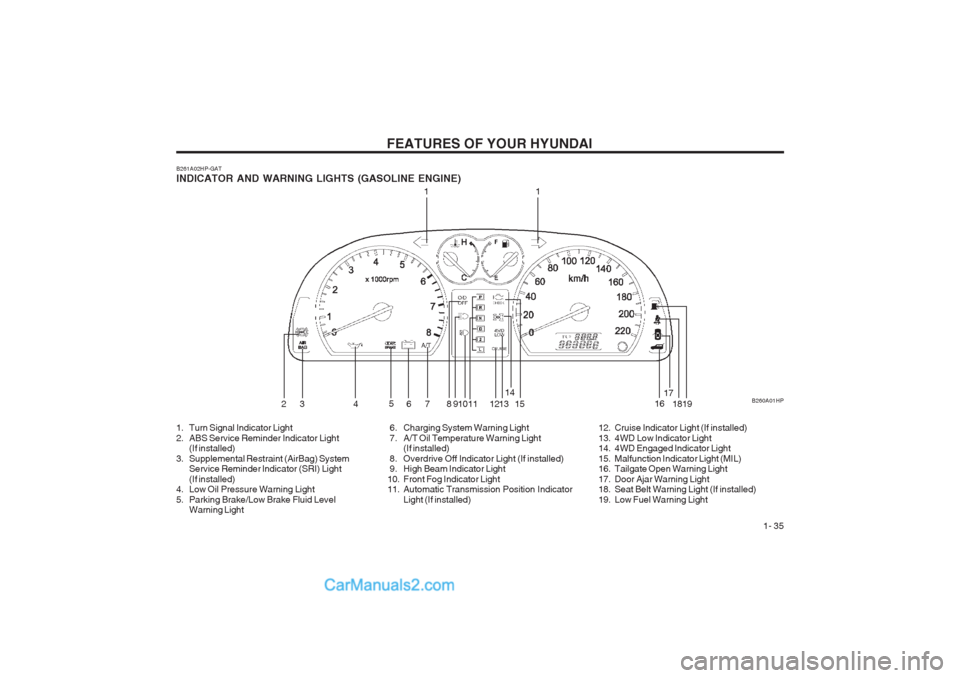
FEATURES OF YOUR HYUNDAI 1- 35
B261A02HP-GAT INDICATOR AND WARNING LIGHTS (GASOLINE ENGINE) B260A01HP
11
23 4 5
6 7 8 910 11 1213 14
15 1617
18
19
1. Turn Signal Indicator Light
2. ABS Service Reminder Indicator Light (If installed)
3. Supplemental Restraint (AirBag) System Service Reminder lndicator (SRI) Light(If installed)
4. Low Oil Pressure Warning Light
5. Parking Brake/Low Brake Fluid Level Warning Light 6. Charging System Warning Light
7. A/T Oil Temperature Warning Light
(If installed)
8. Overdrive Off Indicator Light (If installed)
9. High Beam Indicator Light
10. Front Fog Indicator Light
11. Automatic Transmission Position Indicator Light (If installed) 12. Cruise Indicator Light (If installed)
13. 4WD Low Indicator Light
14. 4WD Engaged Indicator Light
15. Malfunction Indicator Light (MIL)
16. Tailgate Open Warning Light
17. Door Ajar Warning Light
18. Seat Belt Warning Light (If installed)
19. Low Fuel Warning Light
Page 45 of 349
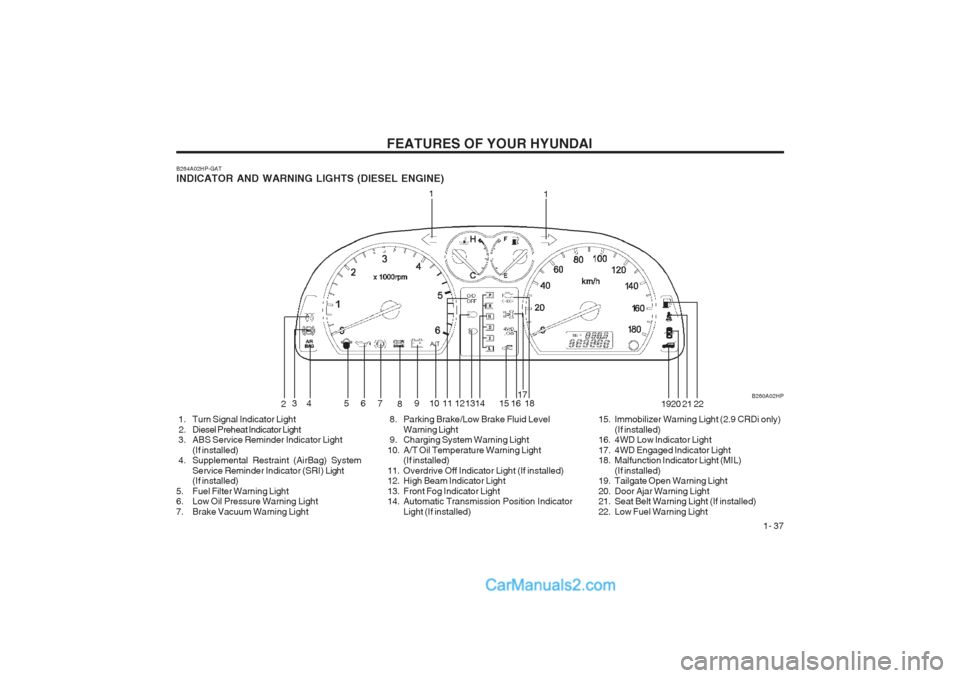
FEATURES OF YOUR HYUNDAI 1- 37
B260A02HP
B264A02HP-GAT INDICATOR AND WARNING LIGHTS (DIESEL ENGINE)
1
2 34 5 6
7
8910111213 15 17
18 1920 21
1
22
1416
1. Turn Signal Indicator Light
2. Diesel Preheat Indicator Light
3. ABS Service Reminder Indicator Light(If installed)
4. Supplemental Restraint (AirBag) System
Service Reminder Indicator (SRI) Light
(If installed)
5. Fuel Filter Warning Light
6. Low Oil Pressure Warning Light
7. Brake Vacuum Warning Light 8. Parking Brake/Low Brake Fluid Level
Warning Light
9. Charging System Warning Light
10. A/T Oil Temperature Warning Light (If installed)
11. Overdrive Off Indicator Light (If installed)
12. High Beam Indicator Light
13. Front Fog Indicator Light
14. Automatic Transmission Position Indicator Light (If installed) 15. Immobilizer Warning Light (2.9 CRDi only)
(If installed)
16. 4WD Low Indicator Light
17. 4WD Engaged Indicator Light
18. Malfunction Indicator Light (MIL)
(If installed)
19. Tailgate Open Warning Light
20. Door Ajar Warning Light
21. Seat Belt Warning Light (If installed)
22. Low Fuel Warning Light
Page 48 of 349
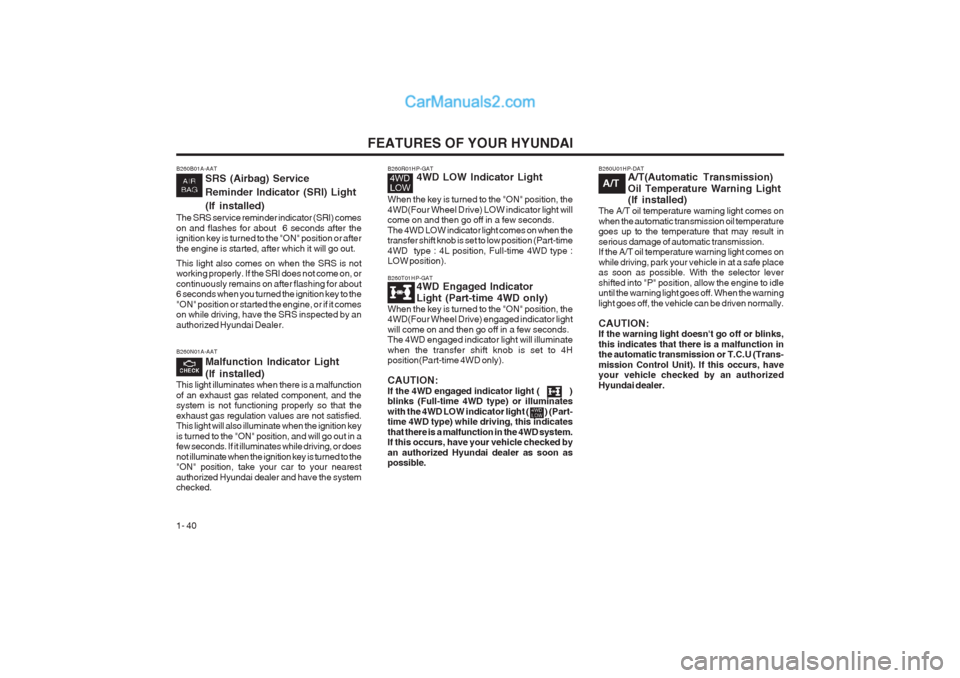
FEATURES OF YOUR HYUNDAI
1- 40
B260T01HP-GAT 4WD Engaged Indicator Light (Part-time 4WD only)
When the key is turned to the "ON" position, the 4WD(Four Wheel Drive) engaged indicator light will come on and then go off in a few seconds. The 4WD engaged indicator light will illuminate when the transfer shift knob is set to 4H position(Part-time 4WD only). CAUTION: If the 4WD engaged indicator light ( ) blinks (Full-time 4WD type) or illuminates
with the 4WD LOW indicator light ( ) (Part- time 4WD type) while driving, this indicates that there is a malfunction in the 4WD system. If this occurs, have your vehicle checked by an authorized Hyundai dealer as soon as possible. B260U01HP-DAT
A/T(Automatic Transmission)
Oil Temperature Warning Light (If installed)
The A/T oil temperature warning light comes on when the automatic transmission oil temperature goes up to the temperature that may result in serious damage of automatic transmission. If the A/T oil temperature warning light comes on while driving, park your vehicle in at a safe place
as soon as possible. With the selector levershifted into "P" position, allow the engine to idle until the warning light goes off. When the warning light goes off, the vehicle can be driven normally. CAUTION: If the warning light doesn't go off or blinks, this indicates that there is a malfunction in
the automatic transmission or T.C.U (Trans- mission Control Unit). If this occurs, have your vehicle checked by an authorized Hyundai dealer.
A/T
B260N01A-AAT
Malfunction Indicator Light (If installed)
This light illuminates when there is a malfunction of an exhaust gas related component, and the system is not functioning properly so that the exhaust gas regulation values are not satisfied. This light will also illuminate when the ignition key is turned to the "ON" position, and will go out in a few seconds. If it illuminates while driving, or does not illuminate when the ignition key is turned to the "ON" position, take your car to your nearest authorized Hyundai dealer and have the system checked.
B260R01HP-GAT 4WD LOW Indicator Light
When the key is turned to the "ON" position, the 4WD(Four Wheel Drive) LOW indicator light will come on and then go off in a few seconds.
The 4WD LOW indicator light comes on when the transfer shift knob is set to low position (Part-time 4WD type : 4L position, Full-time 4WD type :
LOW position).B260B01A-AAT SRS (Airbag) Service Reminder Indicator (SRI) Light(If installed)
The SRS service reminder indicator (SRI) comes on and flashes for about 6 seconds after the ignition key is turned to the "ON" position or after the engine is started, after which it will go out. This light also comes on when the SRS is not working properly. If the SRI does not come on, or continuously remains on after flashing for about 6 seconds when you turned the ignition key to the "ON" position or started the engine, or if it comes on while driving, have the SRS inspected by an authorized Hyundai Dealer.
Page 205 of 349
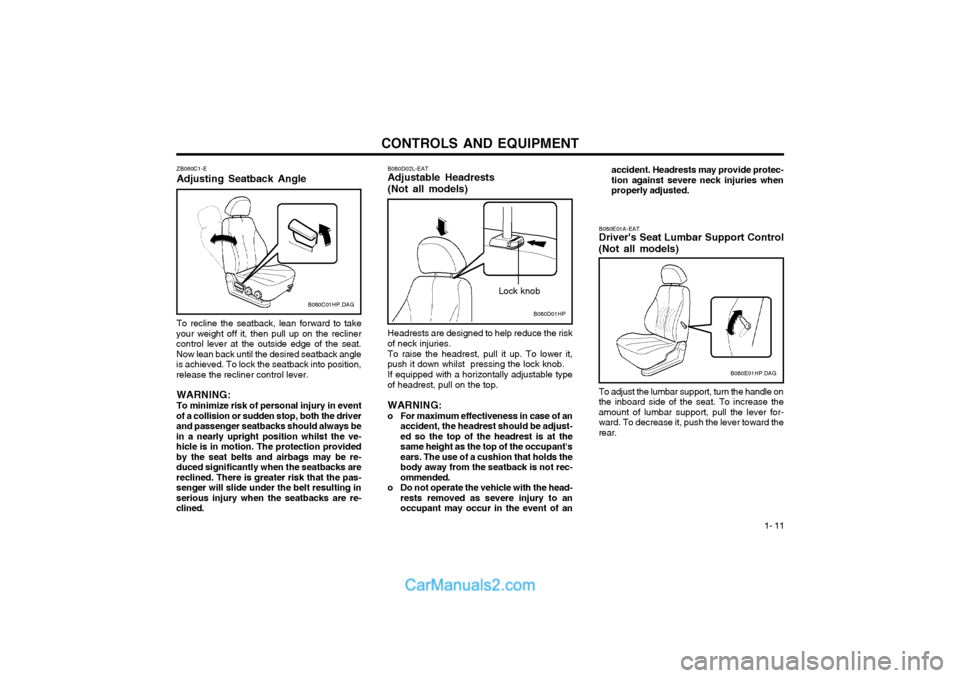
CONTROLS AND EQUIPMENT1- 11
To recline the seatback, lean forward to take
your weight off it, then pull up on the recliner control lever at the outside edge of the seat.Now lean back until the desired seatback angleis achieved. To lock the seatback into position,release the recliner control lever.
WARNING: To minimize risk of personal injury in event
of a collision or sudden stop, both the driver and passenger seatbacks should always bein a nearly upright position whilst the ve-hicle is in motion. The protection providedby the seat belts and airbags may be re-duced significantly when the seatbacks arereclined. There is greater risk that the pas-senger will slide under the belt resulting inserious injury when the seatbacks are re-clined. ZB060C1-E Adjusting Seatback Angle
B080C01HP.DAG
To adjust the lumbar support, turn the handle on the inboard side of the seat. To increase theamount of lumbar support, pull the lever for-ward. To decrease it, push the lever toward therear.
B080D02L-EAT Adjustable Headrests (Not all models) Headrests are designed to help reduce the risk
of neck injuries.
To raise the headrest, pull it up. To lower it,
push it down whilst pressing the lock knob.
If equipped with a horizontally adjustable type
of headrest, pull on the top.
WARNING:
o For maximum effectiveness in case of an accident, the headrest should be adjust- ed so the top of the headrest is at thesame height as the top of the occupant'sears. The use of a cushion that holds thebody away from the seatback is not rec-ommended.
o Do not operate the vehicle with the head- rests removed as severe injury to anoccupant may occur in the event of an B080E01A-EAT Driver's Seat Lumbar Support Control
(Not all models)
B080E01HP.DAG
B080D01HP
Lock knob accident. Headrests may provide protec- tion against severe neck injuries whenproperly adjusted.
Page 218 of 349
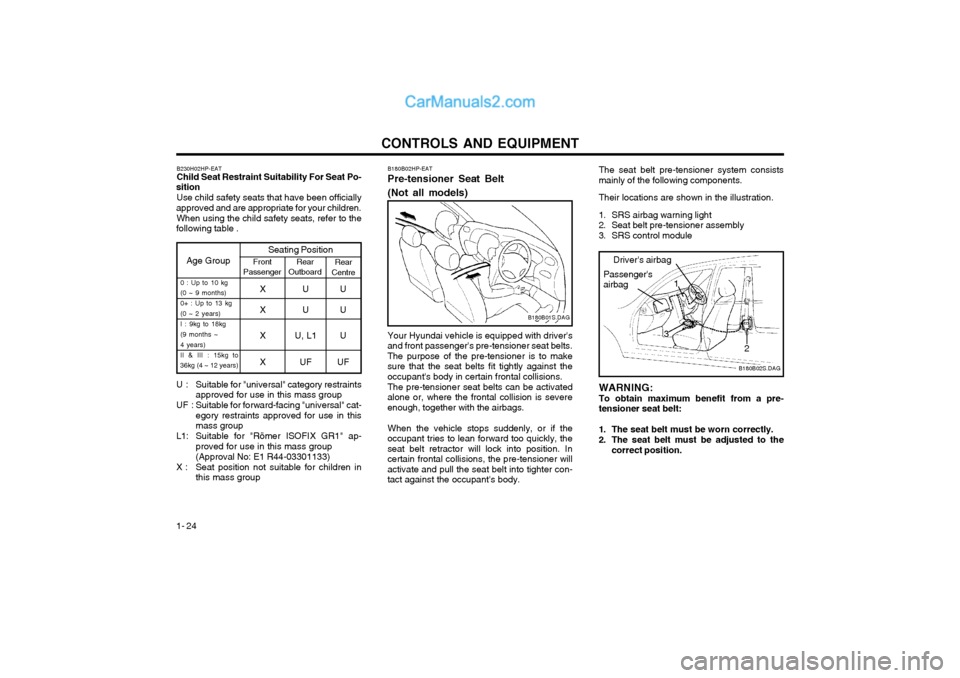
CONTROLS AND EQUIPMENT
1- 24 The seat belt pre-tensioner system consists mainly of the following components. Their locations are shown in the illustration.
1. SRS airbag warning light
2. Seat belt pre-tensioner assembly
3. SRS control module WARNING: To obtain maximum benefit from a pre-tensioner seat belt:
1. The seat belt must be worn correctly.
2. The seat belt must be adjusted to the
correct position.
Age Group Seating PositionFront
Passenger Rear
Outboard Rear
Centre
0 : Up to 10 kg (0 ~ 9 months) 0+ : Up to 13 kg(0 ~ 2 years)I : 9kg to 18kg(9 months ~4 years) II & III : 15kg to
36kg (4 ~ 12 years)XUU
XUU
X U, L1 U XU FUF
B230H02HP-EAT Child Seat Restraint Suitability For Seat Po-
sition
Use child safety seats that have been officially
approved and are appropriate for your children.
When using the child safety seats, refer to the
following table .
U : Suitable for "universal" category restraints approved for use in this mass group
UF : Suitable for forward-facing "universal" cat- egory restraints approved for use in this mass group
L1: Suitable for "Römer ISOFIX GR1" ap- proved for use in this mass group (Approval No: E1 R44-03301133)
X : Seat position not suitable for children in this mass group Your Hyundai vehicle is equipped with driver's
and front passenger's pre-tensioner seat belts. The purpose of the pre-tensioner is to makesure that the seat belts fit tightly against theoccupant's body in certain frontal collisions.
The pre-tensioner seat belts can be activated
alone or, where the frontal collision is severeenough, together with the airbags.
When the vehicle stops suddenly, or if the
occupant tries to lean forward too quickly, theseat belt retractor will lock into position. Incertain frontal collisions, the pre-tensioner willactivate and pull the seat belt into tighter con-tact against the occupant's body. B180B02HP-EAT Pre-tensioner Seat Belt (Not all models)
B180B01S.DAG
B180B02S.DAG
Driver's airbag
1
Passenger's airbag
3
2
Page 219 of 349
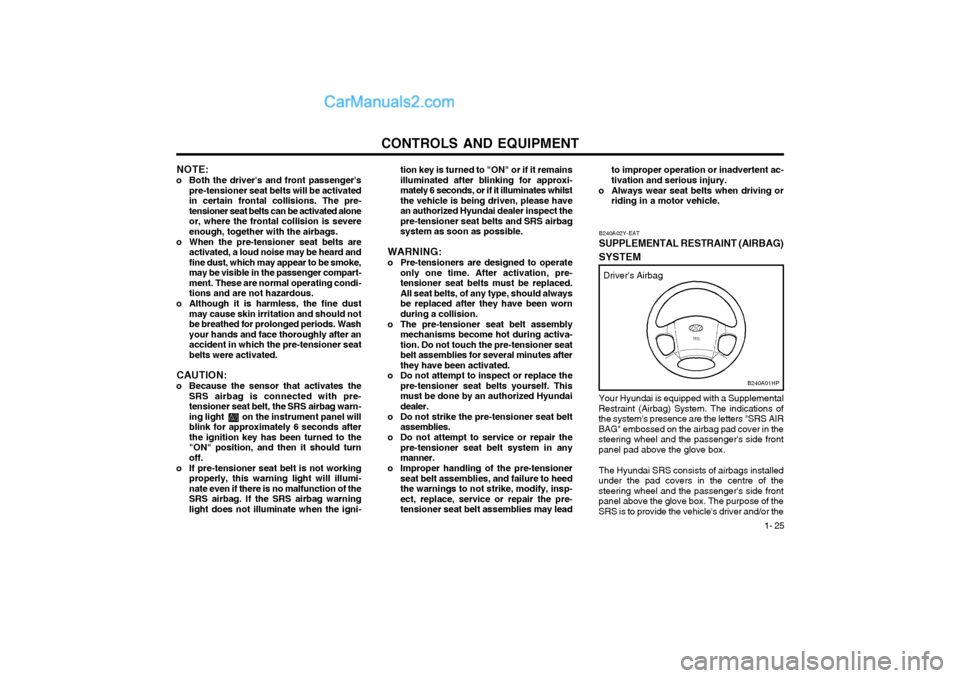
CONTROLS AND EQUIPMENT1- 25
tion key is turned to "ON" or if it remains illuminated after blinking for approxi-mately 6 seconds, or if it illuminates whilstthe vehicle is being driven, please havean authorized Hyundai dealer inspect thepre-tensioner seat belts and SRS airbagsystem as soon as possible.
WARNING:
o Pre-tensioners are designed to operate only one time. After activation, pre- tensioner seat belts must be replaced.All seat belts, of any type, should alwaysbe replaced after they have been wornduring a collision.
o The pre-tensioner seat belt assembly mechanisms become hot during activa-tion. Do not touch the pre-tensioner seatbelt assemblies for several minutes afterthey have been activated.
o Do not attempt to inspect or replace the pre-tensioner seat belts yourself. Thismust be done by an authorized Hyundaidealer.
o Do not strike the pre-tensioner seat belt assemblies.
o Do not attempt to service or repair the pre-tensioner seat belt system in anymanner.
o Improper handling of the pre-tensioner seat belt assemblies, and failure to heedthe warnings to not strike, modify, insp-ect, replace, service or repair the pre-tensioner seat belt assemblies may lead to improper operation or inadvertent ac-tivation and serious injury.
o Always wear seat belts when driving or riding in a motor vehicle.
NOTE:
o Both the driver's and front passenger's pre-tensioner seat belts will be activatedin certain frontal collisions. The pre-tensioner seat belts can be activated aloneor, where the frontal collision is severeenough, together with the airbags.
o When the pre-tensioner seat belts are activated, a loud noise may be heard andfine dust, which may appear to be smoke,may be visible in the passenger compart-ment. These are normal operating condi-tions and are not hazardous.
o Although it is harmless, the fine dust may cause skin irritation and should notbe breathed for prolonged periods. Washyour hands and face thoroughly after anaccident in which the pre-tensioner seatbelts were activated.
CAUTION:
o Because the sensor that activates the SRS airbag is connected with pre-tensioner seat belt, the SRS airbag warn-ing light on the instrument panel willblink for approximately 6 seconds afterthe ignition key has been turned to the"ON" position, and then it should turnoff.
o If pre-tensioner seat belt is not working properly, this warning light will illumi-nate even if there is no malfunction of theSRS airbag. If the SRS airbag warninglight does not illuminate when the igni-
AIR
BAG
Your Hyundai is equipped with a Supplemental
Restraint (Airbag) System. The indications of the system's presence are the letters "SRS AIRBAG" embossed on the airbag pad cover in thesteering wheel and the passenger's side frontpanel pad above the glove box.
The Hyundai SRS consists of airbags installed
under the pad covers in the centre of thesteering wheel and the passenger's side frontpanel above the glove box. The purpose of theSRS is to provide the vehicle's driver and/or the
B240A01HP
Driver's Airbag
B240A02Y-EAT
SUPPLEMENTAL RESTRAINT (AIRBAG)
SYSTEM
Page 220 of 349

CONTROLS AND EQUIPMENT
1- 26 B240B02A-EAT SRS Components and Functions
B240B01L-D
The SRS consists of the following components:
- Driver's Airbag Module
- Passenger's Airbag Module
- Knee Bolster
- SRS Service Reminder Indicator (SRI)
- SRS Control Module (SRSCM)
The SRSCM continually monitors all elements whilst the ignition is "ON" to determine if afrontal or near-frontal impact is severe enoughto require airbag deployment.o Front airbags are not intended to deploy in side-impact, rear-impact or rollover crashes. In addition, airbags will not nor-mally deploy in frontal crashes below thedeployment threshold speed.
o For maximum safety protection in all types of crashes, all occupants includingthe driver should always wear their seatbelts whether or not an airbag is alsoprovided at their seating position to mini-mize the risk of severe injury or death inthe event of a crash. Do not sit or leanunnecessarily close to the airbag whilstthe vehicle is in motion.
o The SRS airbag system must deploy very rapidly to provide protection in a crash. Ifan occupant is out of position because ofnot wearing a seat belt, the airbag mayforcefully contact the occupant causingserious or fatal injuries.
front passenger with additional protection thanthat offered by the seat belt system alone, incase of a frontal impact of sufficient severity.
NOTE: Be sure to read information about the SRS
on the labels provided on the reverse of the sun visor and in the glove box.
WARNING:
o As its name implies, the SRS is designed to work with, and be supplemental to, thedriver's and the passenger's three pointseat belt systems and is not a substitutefor them. Therefore your seat belts mustbe worn at all times whilst the vehicle isin motion. The airbags deploy only incertain frontal impact conditions severeenough to likely cause significant injuryto the vehicle occupants.
o The SRS is designed to deploy the airbags only when an impact is sufficiently se-vere and when the impact angle is lessthan 30° from the forward longitudinalaxis of the vehicle and will not deploy inside, rear or rollover impacts. Addition-ally, the airbags will only deploy once.Thus, seat belts must be worn at alltimes.
o Front airbags are not intended to deploy in light collisions in which protection canbe provided by the seat belt alone.
B240C01HP
Rear impact
Side impact Rollover